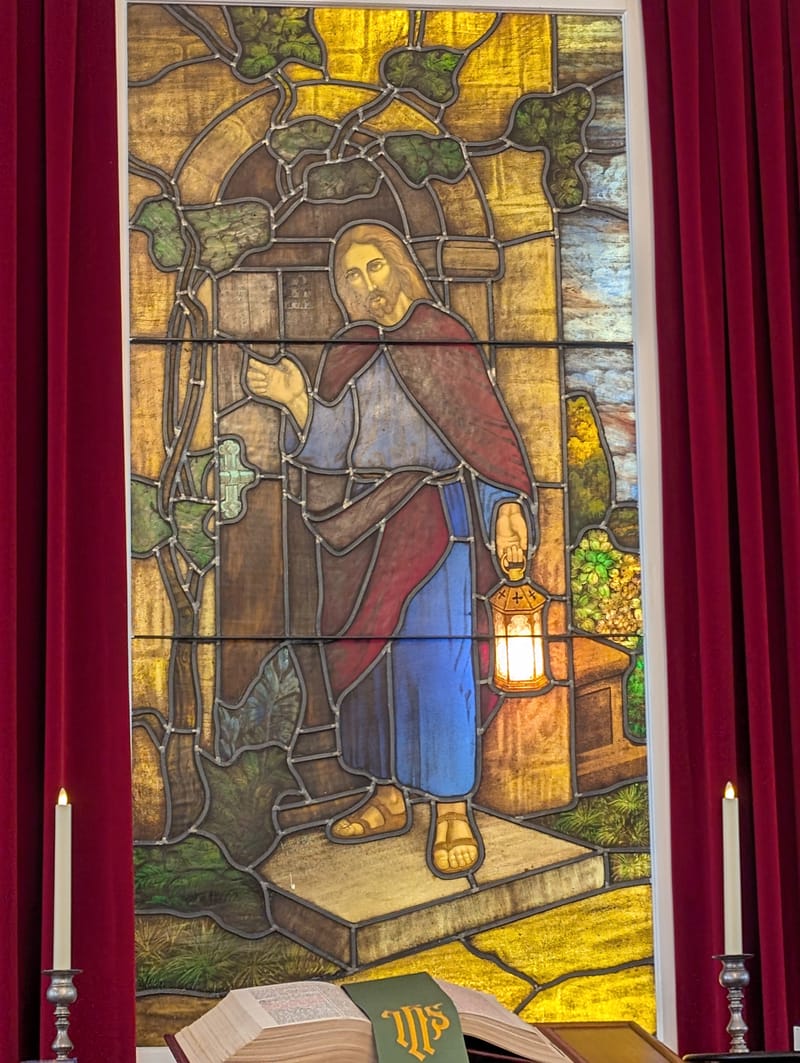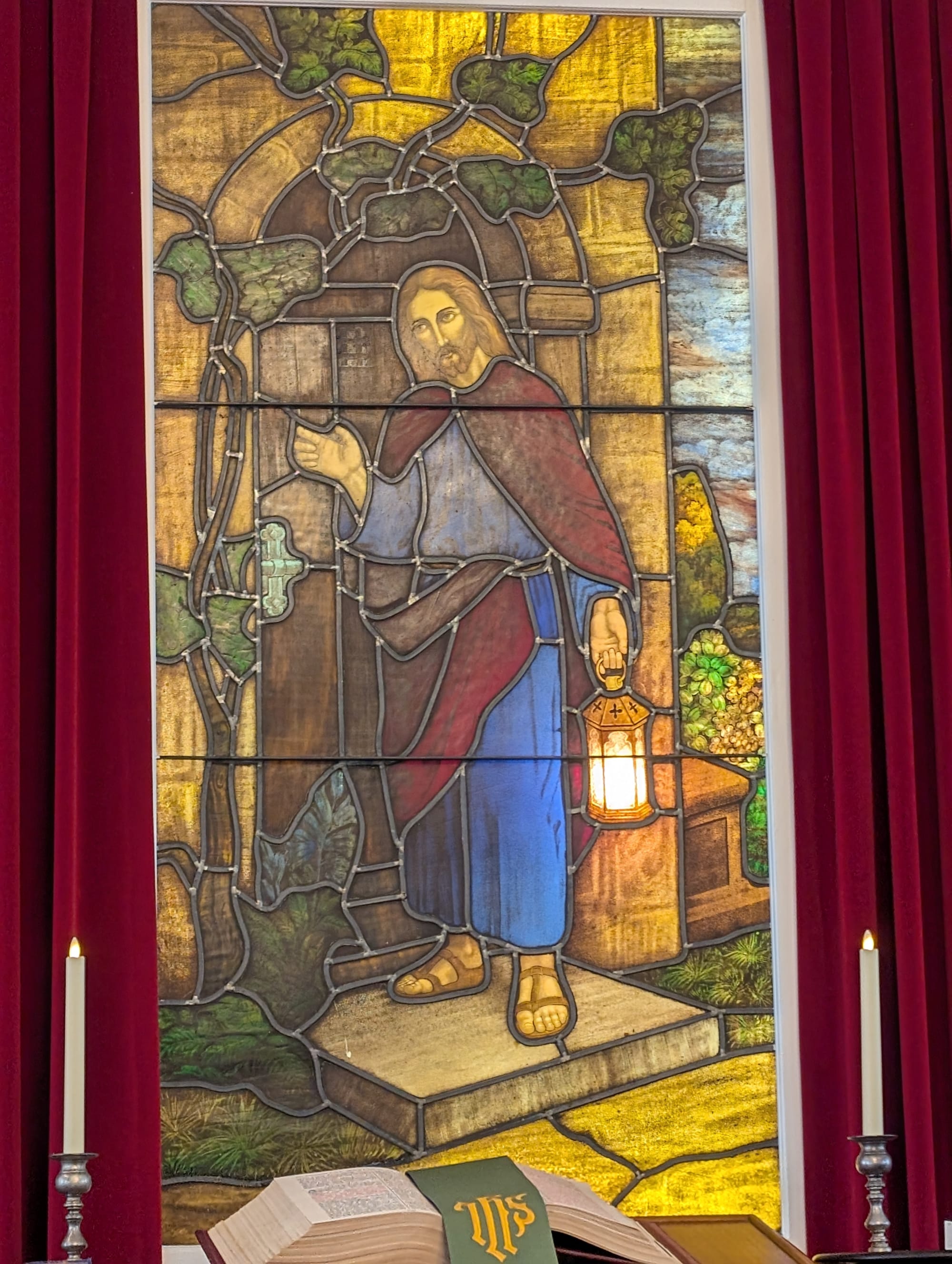"THE WINDOW"

The stained glass window which sits at the altar of our church has a beauty and a history which we should all be aware of. Rarely does a single object have the ability to tie a church membership to its community as neatly and efficiently as our stained glass window does. Camp Bueno staff and North Sutton residents, through the course of these past 60 years, have contributed to “the Window’s” meandering trail. A trail which has landed the Window at the community church here in North Sutton. Revealing this trail would expose lost truths about this special piece of North Sutton’s history.
The origin of the Window would prove to be incredibly significant. The Window was given to us by a gracious and dedicated community member named Miss Mildred Lefferts. Miss Lefferts was the founder and manager of a local girls camp on Kezar Lake. The camp, Camp Bueno, was an effort by Mildred Lefferts to bring young girls from cities like Philadelphia and New York City to Kezar Lake for the summer. The Window was used at Camp Bueno’s Chapel for Sunday religious services.
The staff and leaders of Camp Bueno, a local girls camp, decided to purchase a stained glass window frame to install in the building which housed their chapel. The building was used as a recreation hall and a chapel but it was known primarily as the Chapel. The stained glass would be used during Sunday services at the Chapel for the rest of Camp Bueno’s days. The campers and the staff at Camp Bueno would affectionately refer to the stained glass as “the Window”. For all of us to refer to the stained glass as “the Window” is respectful to it’s rich history and especially to Miss Lefferts and the girls of Camp Bueno.

The Window shows an image of Jesus standing before an arched wooden door of a stone building with ivy lining the doorway, a residence perhaps. Jesus has his right arm extended and it appears as though Jesus has just knocked on the door. Jesus has his left arm draped down along his body while holding a lantern. There is a doorknob on the door. Jesus could open the door himself, but he does not. Jesus waits for us to open the door and let God into our lives.
Our church decided to backlight the Window with the lantern as the center point of the backlighting. This has the effect that the lantern itself is the source of light. The fact that the lantern appears to be the source of light should not be lost on us. Nor should the fact that Jesus is carrying a lantern. The lantern is meant to demonstrate God’s light. Jesus carries the lantern, or God’s light, to show that Jesus is the light of the world. The word “light” is meant to represent life. Those who believe in Jesus as the Savior have eternal life, for God brought light into the world (See John 1:4).
The details of Jesus’ clothing are historically important. Jesus wears a blue tunic. The tunic or “chiton” (Hebrew) that Jesus wears is a simple, thin, one piece tunic (John 19:23-24). Tunics or chitons worn by people of wealth were two pieces and were often long or full-length. This one piece chiton would demonstrate Jesus as a humble man. Jesus wore a common (3/4 length) chiton. Jesus himself would denounce the rich for wearing the full length chiton (Mark 12:38). Jesus also wears a red prayer shawl (Mark 6:56), called a “tallit” (Hebrew) or “himation” (Greek). Jesus was known to have worn this shawl or tallit shortly before his execution on the cross. The “when” of the Window would seem to be at a time shortly before the death of Our Savior. Jesus walked in sandals (Matthew 3:11; Mark 1:7, 6:9; John 1:27) and we now know what ancient Judaean sandals were like as sandals from that age have been preserved in dry caves by the Dead Sea. Knowing the details in the scene of the Window now seems to bring the stained glass at our altar into focus.
A long time friend and colleague of Miss Lefferts, Elizabeth (Lib) Traynor, was the person who was charged with the care of the Window when Camp Bueno closed and the eventual passing of the Window to the First Free Will Baptist Church. Lib Traynor wrote a letter to our church while turning the Window over to the First Free Will Baptist Church. Camp Bueno’s history is introduced and included in the letter. Lib Traynor also left us with a Camp Bueno hymnal which is included in this presentation.
The letter from Lib Traynor that is presented here was found while cleaning up the children's area on the first floor of our church. Included in the discovery was the letter from Lib Traynor, the hymnal from Camp Bueno, and some photos of our congregational area from the 1980s. This discovery of these items would move the research of the Window ahead by leaps and bounds. All of this firmly connects our church here in North Sutton to Camp Bueno and more importantly to the community which we serve.
Camp Bueno, the girls who camped there, and Mildred Lefferts were focused on a few core ideals. Mildred Lefferts had a vision to help young girls learn how to be respectful, religious minded young ladies. Ms. Lefferts’ vision was a wide, sweeping idea that would improve the lives of each and every camper. Athletics, personal growth, trust, and certainly not last, religion were core virtues which were focused on by the staff and leaders of Camp Bueno. This is important for us here in the community and especially in the church to know. Our focus as a church and a community should and does include the same virtues (Athletics maybe not so much).
The First Free Will Baptist Church should have great respect for Mildred Lefferts and the staff of Camp Bueno for the care and donation of the Window to our sanctuary. It is a compliment that we learn the history of the Window and how it adorned the halls of Camp Bueno’s Chapel. The challenge to our church membership is for the Window to become understood for what it really is. Even if that means something different for each of us. Our congregation needs to be proud that we are the current custodians of the Window.
Respectfully Researched and Submitted by,
Robert C. Ray II


